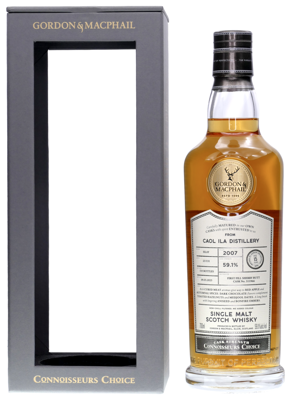|
|
Release Notes
One of 535 bottles drawn from First Fill Sherry Butt #311966 on March 9th of 2023. Originally distilled in 2007. Batch 23/131.
From the Bottle
3rd Party Tasting Notes
Rich cured meat aromas give way to red apple and autumnal spices. Dark chocolate flavors complement toasted hazelnuts and medjool dates. A long finish with lingering aniseed and bonfire embers.
From the Bottle
The Bottler: Gordon & MacPhail
| Established: 1895 |
| Silent since: False |
| Address: George House, Boroughbriggs Road, Elgin, Moray, Scotland IV30 1JY, UK |
| → website |
Just as his father had introduced him to the firm, so George brought in his own children. The oldest, Ian, joined in 1967, after having been trained in the wine and spirit trade in London and France. He was followed by David in 1972 and Michael in 1981. The former had studied business in Aberdeen; Michael is a Chartered Accountant. George"s daughter, Rosemary joined in 1990, after raising her family.
The family partnership became a limited company in the late 1970s, but ownership and management remained with the family, as it does to this day. George Urquhart died in 2001, five years before his grandsons Stephen Rankin and Neil Urquhart were appointed Associate Directors.
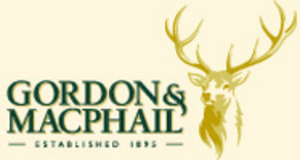
John Urquhart was joined by his son, George, and daughter, Betty, in 1933, and by another son, Gordon, in 1950. By this time the family firm held the largest range of bottled malt whiskies in the world. Most makes were unavailable elsewhere, since very few distillery owners bottled their own malts as singles - indeed, it is no overstatement to say that Gordon & MacPhail single-handedly kept the amber lamp of aged malt whisky burning during the post-war decades!
In the mid-1960s George Urquhart took the unprecedented step of launching a range of single malts from different distilleries under the brand name "Connoisseur"s Choice", and offered the range for sale in the rapidly expanding Italian, French, American and Dutch markets. This move laid the foundations for the significant interest in malt whisky in these countries that remains to this day.
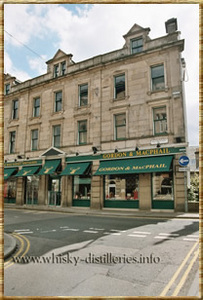
Among the new shop"s first employees was John Urquhart, a lad of fifteen who was to serve his apprenticeship under the partners. He was an able learner, and before long was helping James Gordon to select and buy casks of malt whisky from local distilleries, and assisting with the creation of house blends for the firm"s customers around the north of Scotland. When J.A. MacPhail retired in March 1915, Urquhart became a partner in the business, and when James Gordon died suddenly only two weeks later, he became senior partner.
In parallel with the grocery side of the enterprise, John Urquhart developed the whisky broking business begun by James Gordon, and in particular began to specialise in single malt whiskies - bottling under license for famous distilleries such as Macallan, Glenlivet, Glen Grant, Linkwood and Mortlach. As part of this business he began to select and fill his own casks - almost always Spanish oak, ex-sherry casks - at these and other distilleries, and to mature his whiskies for much longer than was customary at the time.
On 24th May 1895, the Elgin Courant reported the opening "in New, Centrical, and Commodious Premises, No"s 38 and 40 South Street... a Family Grocers, Tea, Wine & Spirit Merchants". The founders of the firm were James Gordon and John Alexander MacPhail, and from the outset (as the newspaper reported) the stock was "personally selected", with a view to providing "a superior article at a popular price" and giving "the utmost satisfaction".
from Gordon & MacPhail
The Distillery: Caol Ila
| Established: 1846 |
| Silent since: False |
| Address: Port Askaig, Isle Of Islay PA46 7RL, United Kingdom |
| → website |
2009 - A ten years old version of the unpeated variety is released at an even higher cask strength than the 8yo.
The Caol Ila distillery on Islay is located near Port Askaig, on the northeast corner of the island. It"s quite isolated, it"s closest neighbor being the Bunnahabhain distillery. Caol Ila was built in 1846 by Hector Henderson who also owned the old Camlachie distillery in Glasgow.
Although the profile of Caol Ila as a single malt has been enhanced in recent years, the main function of the distillery is still the production of malt whiskies for the Johnnie Walker blends. It might surprise you to learn that part of that whisky is actually unpeated - while Caol Ila is known mostly for their peated whiskies. The distillery actually started with trial runs with unpeated whisky in the 1980"s; the so-called "Highland" Caol Ila. For circa two decades this whisky was used almost exclusively for blends, but in 2006 it was introduced as an 8 years old single malt.
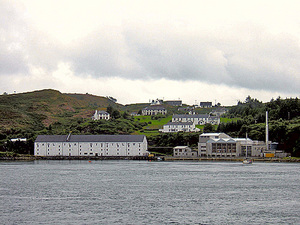
In the new Millenium
The Caol Ila distillery became part of the United Distillers conglommerate in 1986. In 1989 the first "semi-official" bottling of Caol Ila was released in the "Fauna & Flora" range. This would be the only official bottling in a long time (not counting the releases in UDV"s "Rare Malts" series). Fortunately, official bottlings are widely available these days.
Caol Ila"s current "core range" was introduced in 2002. Apart from the standard 12yo, 18yo and Cask Strength bottlings, Diageo releases occasional single cask bottlings as well. When casks of Lagavulin and Laphroaig became harder to acquire after the year 2000, independent bottlers started to release more and more private and "bastard" bottlings too.
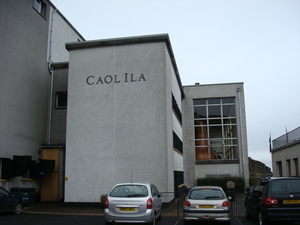
Consecutive owners included Henderson, Lamont & Co (1852-1854), Norman Buchanan (1863-1879) and Bulloch, Lade & Co (proprietors of Camlachie) who rebuilt and expanded the distillery. Caol Ila was liquidated and sold to J. P. O"Brien Ltd in 1920, who in turn sold it to Caol Ila Distillery Co Ltd. the same year. DCL took control in 1927 and transferred Caol Ila to SMD in 1930 who shut it down. Caol Ila was silent until 1937 and had to close down during part of WWII as well.
These were the only periods Caol Ila was silent; despite the many changes in ownership Caol Ila has been in production almost constantly since 1846. After World War II, things proceeded relatively uneventful at Caol Ila for a few decades before it was rebuilt and extended from two to six stills between 1972 and 1974. The distillery was completely rebuilt in order to meet increased demand from the blenders, only the warehouses (still filled with maturing whisky) were spared. After 1974 Caol Ila started to buy their malted barley from the Port Ellen maltings. Some connoisseurs make a clear distinction between the heavier "old" Caol Ila that was produced before 1972 and the lighter, cleaner spirit that was distilled after the expansion in 1974.
2002 - Caol Ila has been one of Diageo"s "volume" distilleries for quite some time. Consequentially, the only (semi-) official releases were a "Flora & Fauna" bottling and a few "UD Rare Malts" expressions. However, at the start of the new millennium Diageo decided that they wanted to strengthen the Caol Ila brand. They introduced a range of official bottlings; the "standard" 12 years old, an 18 years old and a cask strength version (no age statement).
2006 - The Caol Ila "Unpeated" (formerly known as "Caol Ila Highland" to blenders) is released as a 8yo.
Trivia:
- The name Caol Ila (pronounced as "kul-eela" and easily misspelled as Coal Ila) is Gaelic for "Sound of Islay" and is probably inspired by the location of the distillery along the stretch of water between Islay and Jura.
- Caol Ila is the largest distillery on Islay by far; with an annual production capacity of almost 4 million litres of pure alcohol per year - about a quarter of all malt whisky that is distilled on the island. As such, Caol Ila"s capacity dwarfs well known malt whisky brands like Longmorn, Glenfarclas, Highland Park, Laphroaig and Lagavulin.
- Although there is a three storey warehouse on the distillery grounds, these days the entire production is sent to the mainland via tanker trucks. So, young Caol Ila is not filled and matured on Islay.
- After the distillery was remodeled and expanded in 1974 to better suit the needs of blenders Caol Ila introduced a novel new whisky for blenders in the mid 1980"s: an unpeated malt whisky known as "Caol Ila Highland ". This product was intended for blending and most (if not all) casks would thus have gone to blenders for, erm... blending. However, in 1999 Caol Ila resumed production of unpeated whisky for the "single malt" market. These bottlings became available in 2006 or 2007 when Diageo released the first bottling of the Caol Ila 8 Years Old "Unpeated". Since most blenders were not in the habit of storing their casks for very long (with the exception of Douglas Laing, perhaps) there probably are not that many casks of the unpeated Caol Ila Highland around - if any at all...
from Malt Madness
The Owner: Diageo
| Established: 1997 |
| Silent since: False |
| Address: 8 Henrietta Place, London, W1G ONB, UK |
| → website |
Diageo also distributes Unicum, its lighter-bodied variant Zwack and Jose Cuervo tequila products in North America. However, Cuervo operates as a separate company in Mexico and is not owned by Diageo. Similarly Grand Marnier is distributed by Diageo in many markets, including exclusively in Canada, and a deal was reached in 2009 to significantly expand this partnership in Europe.
Furthermore, Diageo owns the Gleneagles Hotel.
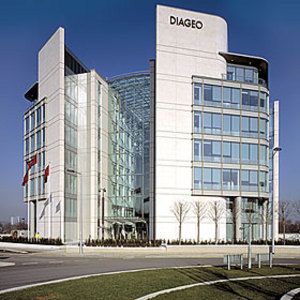
Diageo was formed in 1997 from the merger of Guinness plc and Grand Metropolitan plc. The creation was driven by the two executives Anthony Greener and Philip Yea at Guinness plus George Bull and John McGrath of Grand Metropolitan. The product portfolios of Guinness and Grand Met were largely complementary with little overlap.
Diageo is the world"s biggest whisky producer with 28 malt distilleries and two grain distilleries.The company operates the Scotch whisky distilleries of Auchroisk, Benrinnes, Blair Athol (situated at Pitlochry), Caol Ila, Cardhu, Knockando, Glen Elgin, Clynelish, Cragganmore, Dalwhinnie, Glenkinchie, Glen Ord, Lagavulin, Oban, Royal Lochnagar, Strathmill, Talisker, Teaninich, Mannochmore, Mortlach and Glenlossie, which are sold not only under their own name but used to make the various blended scotch whiskies sold by the company, and owns the stock of many closed distilleries such as Port Ellen, Rosebank, Brora, Convalmore, Glen Albyn, North Brechin, Banff, and Linlithgow. The company have opened a new malt distillery adjacent to their maltings at Roseisle (1st new make spirit produced Spring 2009). This will be one of the largest malt distilleries in Scotland. The new building contains 14 traditional copper pot stills. An expansion programme is also underway at its Cameron Bridge Grain Distillery in Fife that will make it the largest grain distillery in Scotland. Diageo also owns the Port Dundas Grain Distillery in Glasgow, and jointly operates the North British Grain Distillery in Gorgie, Edinburgh, with The Edrington Group.
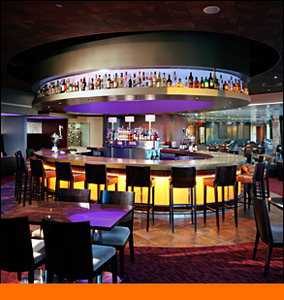
Diageo plc (LSE: DGE, NYSE: DEO) is the largest multinational beer, wine and spirits company in the world. The company is listed on the London Stock Exchange and has American Depositary Receipts listed on the New York Stock Exchange. The word Diageo was formed from the Latin dia (day) and the Greek geo (World), symbolising the use of the company"s brands every day, everywhere. Its head office is located in the City of Westminster in London. It is a constituent of the FTSE 100 Index.
Trivia:
- In December 2003, Diageo provoked controversy over its decision to change its Cardhu brand Scotch whisky from a single malt to a vatted malt (also known as a pure malt) whilst retaining the original name and bottle style. Diageo took this action because it did not have sufficient reserves to meet demand in the Spanish market, where Cardhu had been successful. After a meeting of producers, Diageo agreed to make changes.
- In 2006, the Cardhu brand quietly changed back to being a single malt.
- In July 2009, Diageo announced that, after nearly 200 years of association with the town of Kilmarnock, they would be closing the Johnnie Walker blending and bottling plant as part of restructuring to the business. This would make 700 workers unemployed and caused outrage from press, local people and politicians. A campaign against this decision was launched by the local SNP MSP Willie Coffey and Labour MP Des Browne. A petition was drawn up against the Diageo plans, which also involves the closure of the historic Port Dundas Grain Distillery in Glasgow.
- In February 2009 it was reported in the Guardian that the company had restructured itself so as to avoid paying tax in the U.K., despite much of its profits being generated in the U.K.
- Diageo is engaged in a tax scheme in the United States of America, commonly referred to as the "Rum Bailout", which will guarantee it USD$3 billion in revenues and profits.
- The National Puerto Rican Coalitionplans to run a series of ads in New York City and Puerto Rico urging a boycott of Diageo-owned alcoholic drinks to protest the giant British-owned corporation"s controversial production move of its Captain Morgan rum from Puerto Rico to the U.S. Virgin Islands.
from Wikipedia
